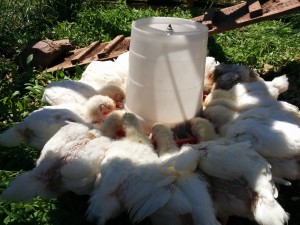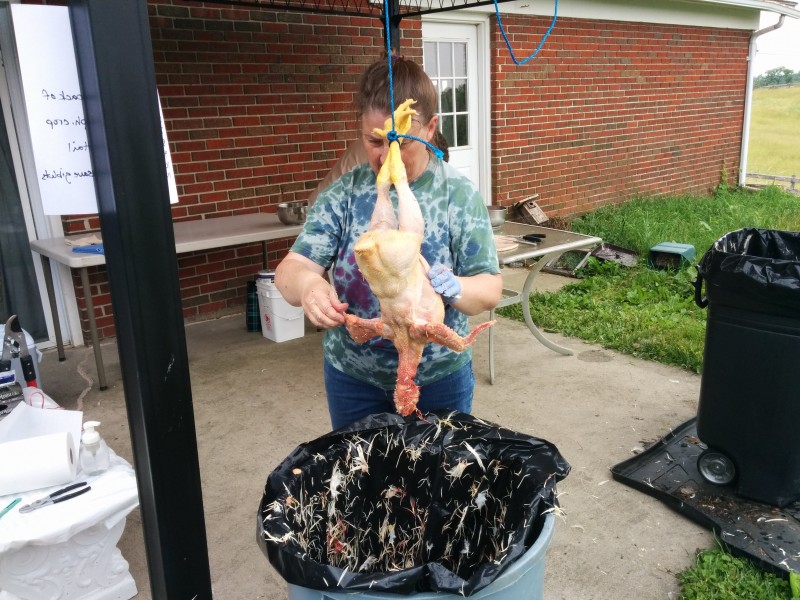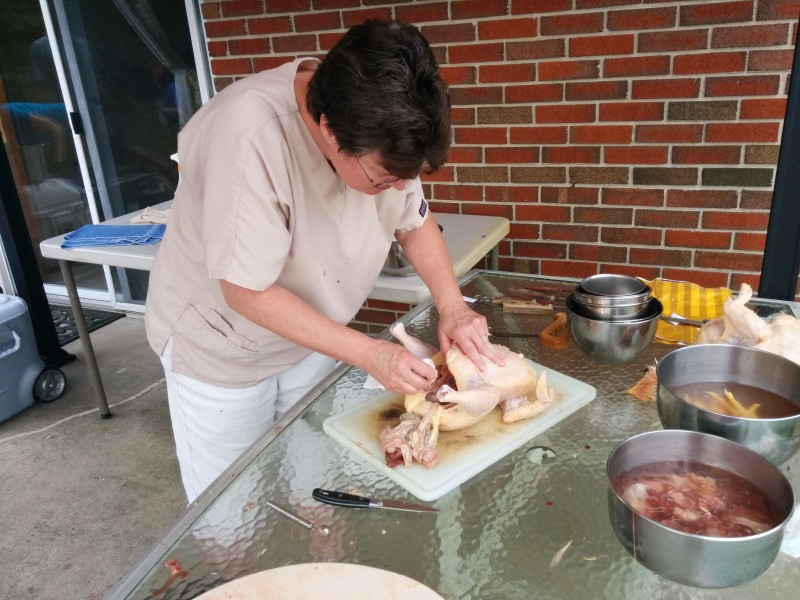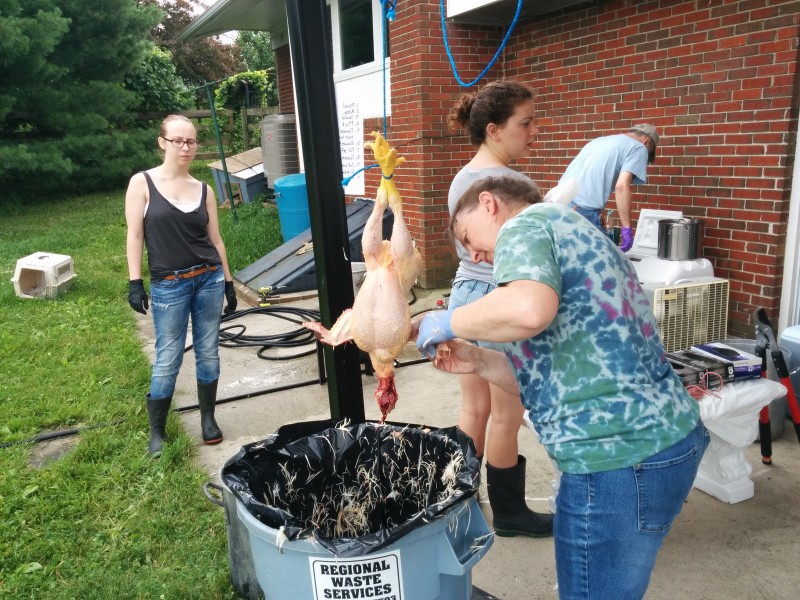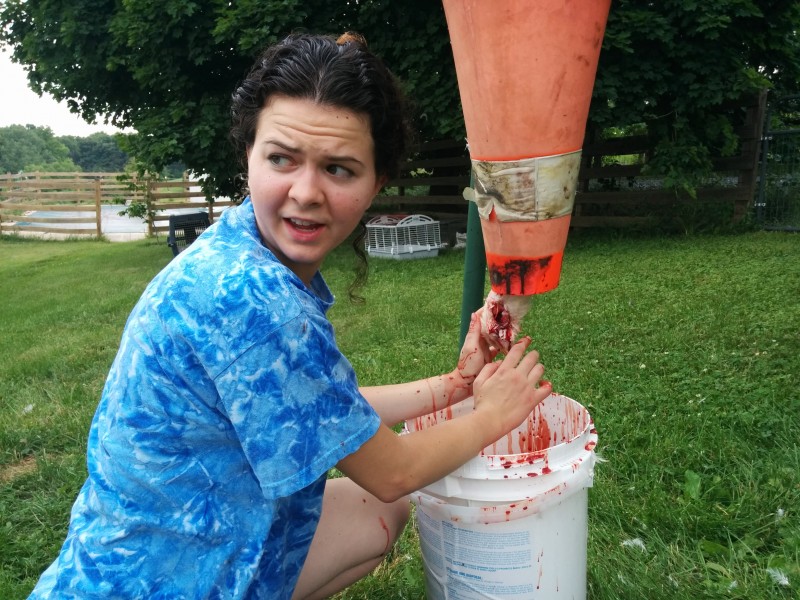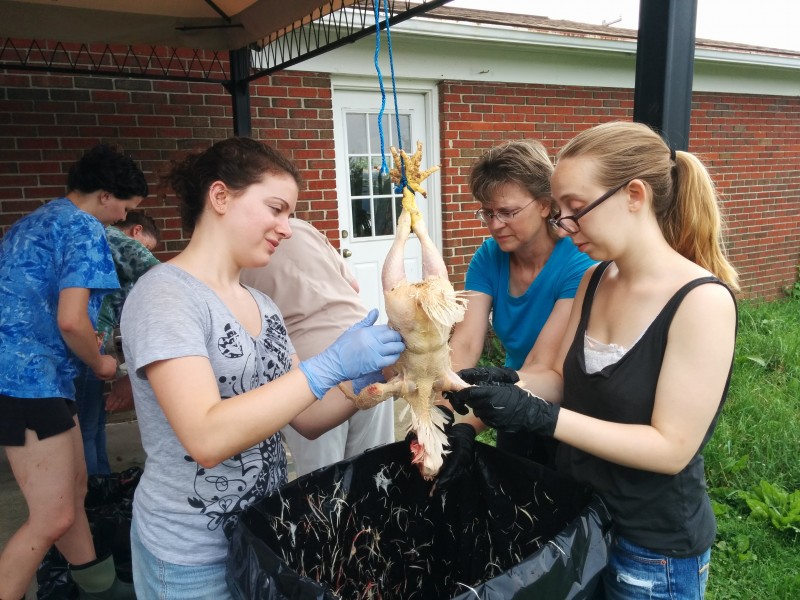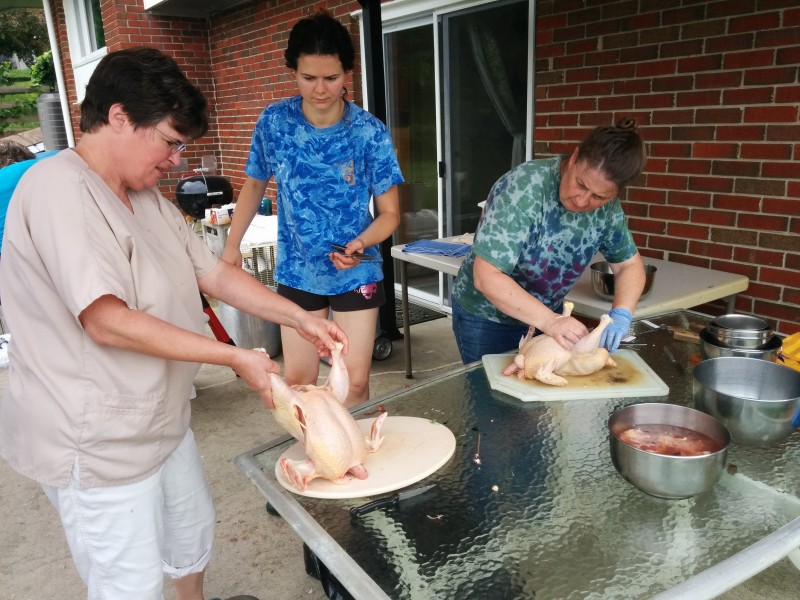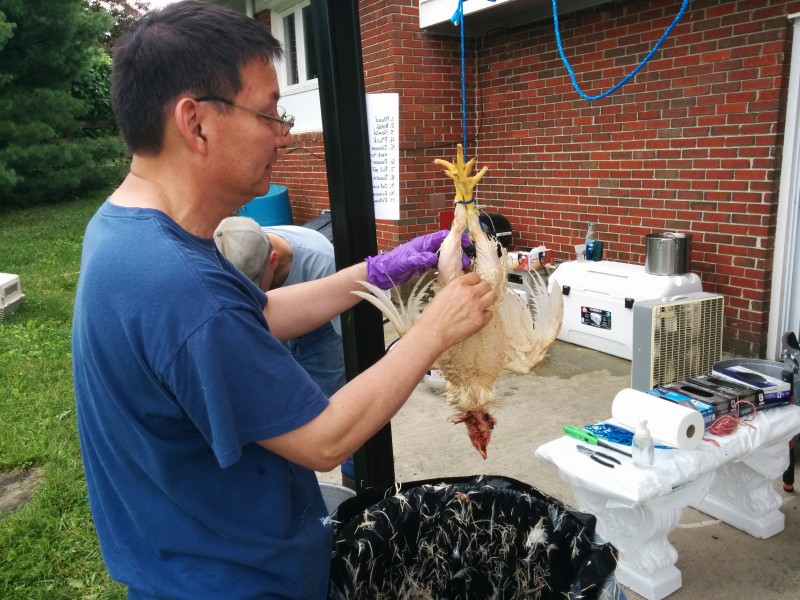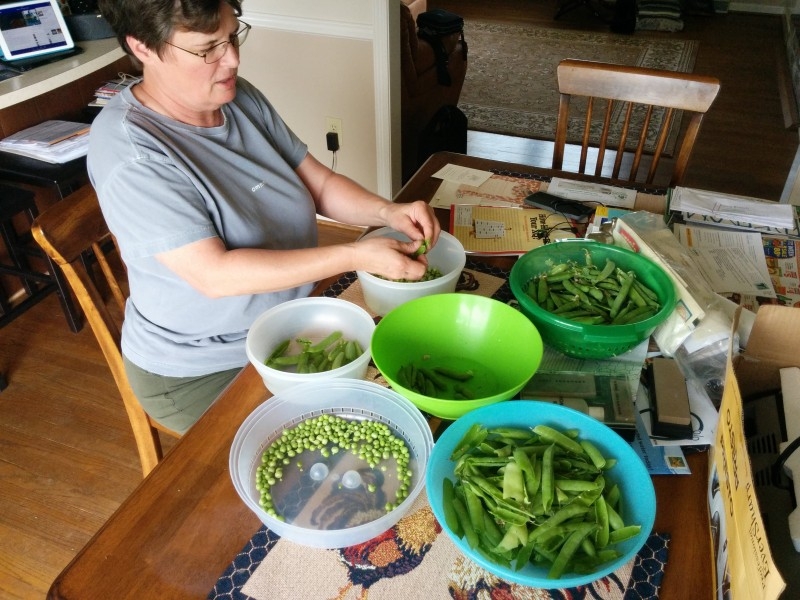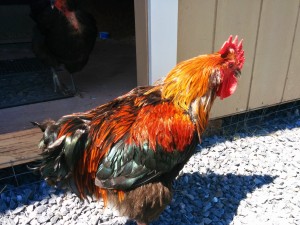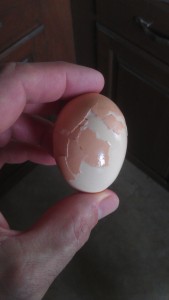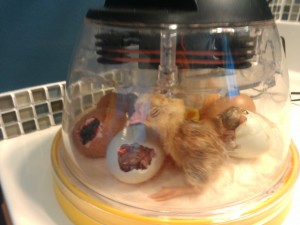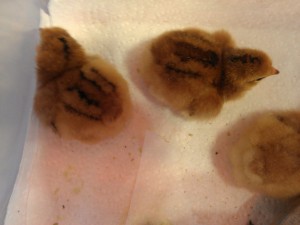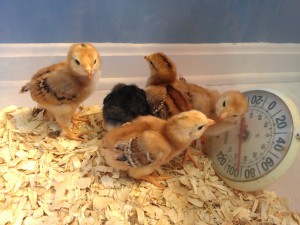Chickens

Meat chickens
0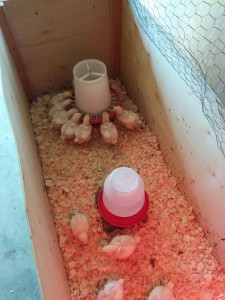 Last year we raised nine meat birds for the first time. In the past we have butchered a few roosters which we got by letting a hen hatch some eggs for us. This is a nice and simple way to increase the laying population, but we also get some roosters that need to be integrated into the flock or eliminated. The take five or six months to reach maturity and tend to be rather lean and tough – which is good in a living bird, but not so good for dinner. So last year we decided to see how real meat birds would be to raise and eat. What a difference! They mature in seven or eight weeks (yes, that’s weeks, not months) and are so fat and juicy and tender. Se we are doing it again this year. We are going from nine to 15 birds this year. They are currently at about three weeks. We never seem to get over how fast they grow and fat they are at such a young age.
Last year we raised nine meat birds for the first time. In the past we have butchered a few roosters which we got by letting a hen hatch some eggs for us. This is a nice and simple way to increase the laying population, but we also get some roosters that need to be integrated into the flock or eliminated. The take five or six months to reach maturity and tend to be rather lean and tough – which is good in a living bird, but not so good for dinner. So last year we decided to see how real meat birds would be to raise and eat. What a difference! They mature in seven or eight weeks (yes, that’s weeks, not months) and are so fat and juicy and tender. Se we are doing it again this year. We are going from nine to 15 birds this year. They are currently at about three weeks. We never seem to get over how fast they grow and fat they are at such a young age.
I still have trouble with raising and killing these animals, but at least it is for food and not sport. That I just can’t imagine. Certainly, some people hunt for sport and eat what they kill. I don’t consider myself any more riteous than anyone else, but I can’t understand how someone can shoot an animal in order to put its head on a wall. End of rant.
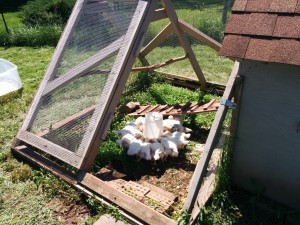 The peeps, if I can still call them that, went outside this morning. The nights are expected to be in the 50s for several days and they are pretty well feathered out, so they should be fine. We spend a half day getting the nursery coop ready for them and they seem happy to have a little more space and some fresh air.
The peeps, if I can still call them that, went outside this morning. The nights are expected to be in the 50s for several days and they are pretty well feathered out, so they should be fine. We spend a half day getting the nursery coop ready for them and they seem happy to have a little more space and some fresh air.
We started feeding them the 24% protein starter food and they finished the bag (40 or 50 lbs), so now they have been switched to the normal starter/grower at 20% and we are letting them run out of food in the evening so they have some time when they are not eating.
We have a processing date at eight weeks, which is a week later than we processed last year. I hope they can still walk by then. These are going to be some very large birds.

Day of homesteading
0Today we processed our nine meat chickens along with 18 more birds from two other families. This isn’t large scale farming, but the largest undertaking of its kind for us. This was the second year for the other families but the first year for us raising meat chickens. These were some generic cross birds we bought at Tractor Supply eight weeks ago. Yeah, Eight weeks! They grow so fast. We have raised several other batches of layers from peeps and they don’t even go outside for eight weeks. And they don’t reach maturity for five or six months. These Cornish Rock crosses grow so fast and have completely different bodies. These are the grocery store chickens that the laying birds are not. We have butchered some roosters at about six months old in the past, and even though they are large and heavy, they just don’t have the meat on them that these birds have.
We had nine people to help with the process and we were quite efficient. We had a killing cone station, a very large cleaning/rinsing tank, one 150 degree dunking tank (dunking between 50 and 60 seconds), two plucking stations and two eviscerating stations. Joni thinks we could have used a third plucking station. We rotated jobs a bit, but Joni did the lion’s share of eviscerating and was very quick about it which was a key to our efficiency and success. The setup was an hour or so and the actual chicken work was only about three hours. Amazing. I was guessing it was going to take most of the day.
We got all the birds in coolers and went inside for a wonderful lunch. Thanks Hawes family. When we got home, I had to rearrange a bunch of beer to make room in the basement refrigerator. We will leave them in the fridge for two or three days and then put them in better bags for freezing. We decided that the Food Saver 11″ bags won’t quite work so we ordered some of the heat shrinking bags that should arrive in the next couple of days. We will also cut up most of the birds for parts, so these could go into the FS bags. The consensus is that a whole chicken is too big for a family of two, so parts is the way to go.
After we had taken care of the chickens for the day, we went out to the garden to pick peas. We got a few snap peas, but mostly picked regular peas. We got a couple of bowls full and shelled them. It’s a lot of work for what seems like a small yield, but we both really love them. They are one of the best vegetables to freeze. They are almost like fresh when thawed.
We spent most of the day working hard for our food. We thought about how this was a way of life many generations ago and were kind of glad we didn’t have to do it every day. But it was a very satisfying day for us.

A new year
0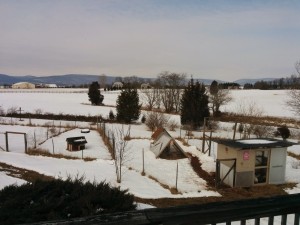 Wow. A whole year has gone by without a post or other update to LLF. Shame on me. I will try to do better this year. The worst part of no updates is that I don’t remember the details of what I planted in the garden and when and what the weather was like and how well the varieties produced. I don’t remember details about the chickens and ducks and my bees.
Wow. A whole year has gone by without a post or other update to LLF. Shame on me. I will try to do better this year. The worst part of no updates is that I don’t remember the details of what I planted in the garden and when and what the weather was like and how well the varieties produced. I don’t remember details about the chickens and ducks and my bees.
I did set up a separate website for a small group of us beekeepers and there was quite a bit of activity on that site. We called ourselves the Honeybee Wranglers and as 2015 progresses we will hopefully build on that information. It has been a long and cold winter just like last year. Maybe not as much snow, but just as long and cold. It is tough for the bees to keep warm and protect the queen and the little bit of brood she may have started producing. So I may not post much about the bees here on the LLF main site, but I will continue to contribute to the Honeybee Wranglers.
In summary, we didn’t do much new with our chickens. We had two chickens die last week. Duran who had some neurological problems in the middle of last year and whom we kept separated from Big Red all fall was found one morning with a very full and hard crop and slumped in the corner of his enclosure. We tended to him in the house for about 24 hours, but he didn’t make it. And then a few days later one of the younger hens was found dead on the floor when we went to open things up in the morning. There was a few other losses over the year. We lost a guinea a few weeks ago – literally lost- as she just disappeared. The guineas can fly out of their yard and perhaps she just got spooked and flew off somewhere and never found her way back. We are down to four now.
We lost a duck to a hawk in early December when we were on a trip to Ohio. Our house sitter called us as we were driving west to give us the news. There were at least two more deaths in the fall. They were only a week or so apart, so I took the second one to the animal health lab for a necropsy and it was determined that she had ILT (Infectious Laryngotracheitis). The state chicken inspector paid us a visit and took cultures (oral swabs) from five birds in each of our three coops. Only the coop where the two chickens died came back positive for ILT, but as a result we were quarantined for two or three months. This means that we take any of our birds off the property during that time. The ban was lifted at the beginning of this year, so we are free to show our championship foul at all the local competitions. Ha ha – not something we do anyway. The virus that causes ILT is a herpes virus and so will be with the birds for life and can be transmitted to other birds. We never saw any of the usual signs of sickness in our flock, but the virus can become life threatening if the birds are ever stressed.

Goodbye ducks, hello chickens
0Last Saturday we went to a chicken swap. We have done this a couple of times before. This one was small and it was a quick trip, but we were meeting someone there to whom we were selling six of our new call ducks. We needed to bring them in a cage which meant that after handing over the six duck and stashing the $50 in my pocket, we had an empty cage and a burning pocket. Maybe you see where I’m going with this. Naturally we couldn’t drive home with an empty cage, so after looking around for 10 minutes we settled on seven new Bantam Cochins. They are not quite full grown but close. They are about half the size of our other chickens. Cochins have very feathery feet and are rather round little things. We bought five hens and were given two roosters.
One of the hens is actually a Belgian D’Uclle. It is a little taller and thinner and has the prettiest Mille Fleur coloring. All the Cochins are supposedly Mille Fleur colored but a couple of them have yet to develop the classic feather tips. I’m not quite sure if that is a regular color for Cochins or if these are crosses of some kind. The two roosters are not Mille Fleur. One is red/brown and the other gray/blue with a brown neck. Coloring may change some as they mature.
We looked longingly at a batch of little quail, but I guess they will have to wait till next year.

A chicken morning
0Yesterday I went to let the chickens out of the palace and I brought my phone/camera. The palace is currently home for 24 birds.

An eventful day on the farm
0Yesterday was quite a day here at Little Lucey Farm. (disclaimer: We’re not really a working farm. We just like to play at it.)
Chickens
In the morning the first order of business is to let the dogs out. It looked like we were going to get a beautiful Sunday to work in the yard. I went to the chicken palace and let the birds out and gave them some scratch. We still have two roosters in with the 17 hens and five guineas. The two roosters continue to get along pretty well. Every once in a while there is a little scirmish, but generally they give each other some space. Big Red is clearly the boss rooster, but Duran can hold his own. We have two broody hens: Daisy, who has been in a nest box for at least two week might be ready to give it up soon, and the larger of the two Barred Rocks who has been in a box for about a week. This is a little bit frustrating, because if we had the Maran rooster and hens in the nursery coop like we wanted, then we could give those eggs to one of the broody hens to raise. The ducks had another idea. Maybe in a couple more weeks we can start the process of raising some pure marans birds.
I opened the original coop to let out those 14 hens and Freddie. These are our four year old birds and the one we handled the most and therefore the most friendly. Tilda and Gertie and Gladys are particularly nice hens. These girls are still laying very well. We’re not sure how long they will keep it up, but so far they are doing great.
We had three yards of mulch delivered a couple of days ago and yesterday we continued to weed and clear out some areas so we could spread the mulch. We are having a party next Saturday, so we were working around the deck. We mulched around the new barrel planters and planted some hens and chicks along the cinder block border that leads to the bees. I was also preparing the garden in order to plant the asparagus that we bought. I never got the tiller running this year, so I was doing all the digging by hand. We were just about finished with the mulching in that area when Joni yelled for me to look at the bees. They had just started to swarm!
Bees
I had my phone which was miraculously charged and was able to get some video. We had never seen the swarming process from start to finish. It only took about 15 minutes, but it was pretty cool to watch. They came out of the hive and swirled up and out in front of the hive and formed a large ‘cloud’ of bees. I got some video from several vantage points. It was spectacular. I suppose their landing spot was never in doubt, but I was watching so I would know where they gathered. Naturally, it was the ‘regular’ spot. It was the same small tree and wild raspberry tangle that all five swarms from last year had used. I really should sell little cuttings or seedling of my magic bee-magnet tree. It clearly has magical powers.
I took seven videos. The second one is shown, but you can watch them all if you are interested. They are only a minute or two each:
Video 1
Video 2
Video 3
Video 4
Video 5
Video 6
Video 7
I let them settle for about a half hour and when I went back to the hives, it looked like business as usual. If I hadn’t seen the swarm, I might have never even noticed. The swarm was very quiet. The bees were still settling down and it didn’t look like the scouts were out in large numbers yet. It was also hidden pretty well in the shrubbery. I had to cut away a lot of the brambles to expose the swarm, but once I did that, it looked like it would be an easy operation. With Joni’s help, we cut the branch from the tree and carried it over to the empty hive box already set up and ready for bees. One shake was all it took, and the bees were in the box – and all over the outside as well. I didn’t want to use smoke to get them to retreat into the box because the bees need to spread the queen’s scent to pull the bees in. I was pretty sure the queen was in the box, so I tried to brush the bees away from the top and was able to get an inner cover on the box. In short order, it was clear that bees were heading in through the front entrance, so the job was almost done.
Last year, I think I had a newly installed swarm reswarm after a few weeks, so this time I wanted to be sure the bees had plenty of space. I decided to put a second deep on right away. Another difference from last year is that these boxes already had frames with comb and perhaps even some old honey or almost honey that went through the winter. There is some risk that there could be some wax moths in these frames, so I will keep a close eye out for them. In the meantime, I will take some other frames and put them in the freezer to kill any wax moths that might be hiding. I still have five or six deep frames from my hive #2 that went through the winter with capped honey in them. I thing the best course of action is to try to feed these back to the bees, so I will try a couple of different things toward this end. Today I will simply scratch open one frame of capped honey onto a cookie sheet to see if the bees will go after that. I suspect they will, but if not maybe either the honey is ‘bad’ in some way or maybe they are still foraging (and preferring) the nectar they are finding in the neighborhood.
Ducks
Dee Dee hatched 10 of her 13 eggs two weeks ago and we felt the need to move them to the nursery coop for protection against snakes. So, unfortunately, the nursery coop is being occupied for another couple of weeks. They have really grown and are very cute. Dee Dee is very protective and generally won’t let us near her babies, but yesterday we wanted to see if they would come out of the coop and take their first swim. We filled a tub with water and with a little help all but one made it into the water. Momma let the way. Normally, duck would like to be swimming a lot, certainly a portion of every day, but Dee Dee has been sitting on her nest for a month and now taking care of little ones with not swimming available – until yesterday. It was clear that she was enjoying the bath.
Wildlife
There was a sad moment in the day, too. We knew that a pair of bluebirds had made a nest in a nest box that has been in the yard for several years. We have watched one or two sets of eggs hatch from that box each year. I had seen eggs in the box a few weeks ago and I thought we would take a look to see if the babies had hatched. When we looked in the box we found three tiny dead baby bluebirds. They looked to me to be less than a week old. There was no sign of mommy or daddy bird. Bluebirds are capable of raising young even if one parent dies. Either parent can do the job. This is especially sad and perplexing. Something must have happened to both parents. And two of the eggs or babies were missing as well. We have a snake guard on the pole, so we don’t think it was a snake, but we just don’t know what happened.

Double egg shell
0I’ve never seen this before, but I guess it occurs occasionally. This egg has two shells. There was a hen in the nest box, but it was probably laid by a hen before her. We have six boxes, but usually all the eggs (about a dozen now) are in just two boxes. This one looked just like this when I removed it. I’m not sure why the outer shell was half gone or why they are such a different color. That kind of suggests that the brown color is something that happens only shortly before the egg is laid.

New Baby Chicks
2The 5 little ones are doing very well – no signs of any illness or pasty butts. I didn’t really plan on having more chicks in the house – it gets to be too messy as they grow and send a lot of dust flying around. We’ve never had a hen that didn’t want to care of her chicks before. The good thing is these chicks will grow up to be very friendly as they get a lot of attention being in the house. They are just so darn cute it’s hard to resist playing with them! It is just amazing to watch how quickly they grow and develop. Here they are just a week after hatching – already getting big and strong and with good sized wings!
Gertie & Violet share babies
0Hens that are broody or incubating eggs usually do not want any other hens near them. They especially do not want any other chickens around after new babies hatch. They are VERY protective and puff up and chase away anyone who dares to come near the little ones. Gertie and Violet have an understanding and are raising 3 little chicks cooperatively. Gertie is one of our original hens and has gone broody each year but we have never allowed her to hatch babies. This year she was not taking “no” for an answer and moved in on Violet as she was setting on a nest of 8 eggs. Violet did not object and the two of them shared nesting duties for most of the 3 weeks it takes for chicks to develop. We were very curious to see how things would go once babies actually arrived and thought there might be some trouble.
Three of the eggs hatched on Saturday 7/14/12. The momma hens continued to cooperate and care for the babies together! One would continue to incubate the remaining eggs while the other would attend to the babies. The other eggs were either infertile or just did not develop properly for some reason and were abandoned after a few days. All that work sitting on those eggs constantly for 3 weeks and 5 did not hatch – what a shame. Gertie and Violet seem very happy with their new chicks, though and it is so cute watching both of them teach the babies all the secrets of being a good chicken.

Patty died but chicks on the way
0Our Partridge Rock hen, Patty, died on Friday. It was over 100 degrees that day, I believe, and it may have been the heat. If not the heat, then I have no idea. These things just happen sometimes  I don’t remember her acting strangely, but I might have missed something. The hot weather continues and the rest of the chickens mostly just stay in the shade. Egg production is down, too, in this heat.
I don’t remember her acting strangely, but I might have missed something. The hot weather continues and the rest of the chickens mostly just stay in the shade. Egg production is down, too, in this heat.
Violet has been setting on eggs for a week now and has two weeks to go. I hope she makes it. I haven’t seen her come out to eat or drink, but she would typically only do that once a day and I might be missing it. She was setting for about two or three weeks before we gave her eggs to hatch, so there is a possibility that she will give up just before these eggs are ready to hatch. If that happens, I will try to incubate them and hope Violet will still be interested in raising them. Today Gertie decided to lend some moral and physical support.
The ‘new’ birds, meaning the ones we bought or raised this spring are now as big as some of the mature hens, although the new hens are still a couple of months away from laying. They are very handsome birds. There are certainly a few boys among them, but none have offered up a cock-a-doodle-do yet, so we can’t be sure.
